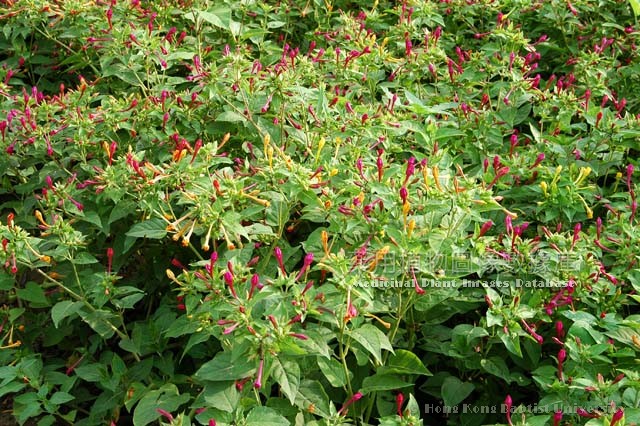|
|
|
Mirabilis jalapa L.

|
English Name |
Four-o’clock, Marvel of Peru, Beauty-of-the-night, Common Four-o’clock |
|
Latin name |
Mirabilis jalapa L. |
|
Family & Genus |
Nyctaginaceae, Mirabilis |
|
Description |
Annual or perennial herbs, 50-100cm tall. Root strong, conical or fusiform, fleshy, surface dark brown, inner white, powdery. Stem erect, much branched, cylindric, knob enlarged. Leaves opposite; long stipitate, below peduncle exceeding half of the blade, upper blade sessile; blades papery, ovate or ovate triangular, 3-10cm long, 3-5cm wide, apex acute, base truncate or slightly heart shaped, entire. Flowers one to more, terminal, integrated to cyme; each flower base has one epicalyx, green, 5 lobed; flowers bisexual, simple perianth, red, pink, white or yellow, perianth tube cylindric, 4-5cm long, upper enlarging to flaring, 5 lobed, flat; stamens 5-6, filament thin and long, longer than or equilong to perianth; pistil 1, ovary superior, ovate, style single 1, slender linear, stigma head shaped, slightly lobed. Achene, nearly spheric, ca. 5mm long, black when ripe, thinly ribbed, wrapped by persistent bracts. Flowering: June to September, fruiting: September to October. |
|
Distribution |
Growing on limesmarginis, at wall foot or in gardens. Often cultivated. Distributed in all parts of China. The medicinal materials are produced in all parts of China. |
|
Part Used |
Medical part: roots, leaves, flowers and fruits. Chinese name: roots: Zimoligen. Leaves: Zimoliye. flowers: Zimolihua. Fruits: Zimolizi. |
|
Harvest & Processing |
Roots: harvested from Oct-Nov in the very year of sowing, excavated the whole roots, washed off sediment, used fresh, or removed the rhizome residue and fibril, scraped bark, cleared dark speckle, sliced, immediately sun-dried or baked to dry. Leaves: collected when flourishing and before flowering, washed and used fresh. Flowers: picked from July to September when flowering, used fresh, or sundried. Fruits: collected mature fruits from Sept-Oct, removed impurities, and sun-dried. |
|
Chemistry |
Roots contain protein, sterol stigmasterol and β-sitosterol. Leaves contain sterides compounds, fatty acid and various free amino acid, etc. Seeds contain starch, fatty acid like 8-hydroxyoctadeca-cis -11 and 14-dienoic acid; β-sitosterol and β-amyrin, etc. |
|
Pharmacology |
Anti-bacterial, antivirotic and anti-tumors, and lapactic. |
|
Properties & Actions |
Root: sweet, tasteless, little cold. Leaves: sweet, tasteless, little cold. Flower: little sweet, cool. Fruits: sweet, little cold.Roots: clearing heat for inducing diuresis, detoxifying for promoting blood circulation. Leaves: clearing heat-toxin, dispelling wind and draining dampness, promoting blood circulation. Flowers: moistening the lung and cooling blood. Fruits: clearing heat and resolving speckle, disinhibiting dampness and detoxifying. |
|
Indications & Usage |
Root: pyretic stranguria, whitish and turbid urine, edema, leucorrhea with red and white discharge, arthralgia and swelling, anthracia and swelling toxicity, mammary abscess, injuries from falls. Leaves: anthracia and sores, sarcoptidosis, injuries from falls. Flower: empsyxis. Fruits: nevus spilus on face, crusted tetter.Roots: oral administration: decocting, 15-30g, fresh products 30-60g. External application: appropriate amount, fresh products smashed for applying. Leaves: external application: appropriate amount, fresh products smashed for applying or extracted juice for unction. Flowers: oral administration: 60-120g, fresh products pounded to extract juice. Fruits: external application: appropriate amount, removed outer shuck, powdered for unction, or decocted for washing. |
|
Examples |
1. Stranguria (difficulty in micturition): primula maximowiczii regel, herb of maidenhair 15g each. Cut into pieces, stew with liquor 60g, warm up and swallow.
2. Sores and furuncles, injuries from fall: an appropriate amount of four-o'clock leaves (fresh). Pestle and apply externally to the affected lesions, one time a day.
3. Empsyxis: white flower of four-o'clock 120g. Pestle collect juice, prepare with winter honey and swallow.
4. Grape sores (skin impetigo, discharging yellow fluid after broken): four-o'clock fruit, grind into a powder, prepare with cold water and smear. |
| Link to |
 Phytochemical Image Database Phytochemical Image Database
 Chinese Medicine Specimen Database Chinese Medicine Specimen Database
|
|
Permanent URL:https://sys01.lib.hkbu.edu.hk/cmed/mpid/detail.php?herb_id=D00772 |
|
|
|

